
1910
History
of the Eloise Butler Wildflower Garden
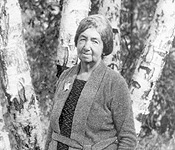
Photo courtesy Minneapolis Public Library, Minneapolis Collection, M2632B
This winter would be the second to the last for Eloise Butler to teach in the Minneapolis School System. While Miss Butler was busy with her full time job her precious Garden rested under a blanket of snow. 1909 ended with over 10 inches of snow depth and with frequent snowfalls in January and February, interspersed with hard cold snaps in early January and late February, the snow cover averaged around 14 to over 16 inches until an above average warm spell occurred at the beginning of March. This warm spell was to last until mid-April, during which time there was little precipitation.
During the school year Eloise contributed an article to School Science and Mathematics, Vol. 10, 1910, in which she advocated for "The Wild Botanic Garden," the name she and her fellow Botany teachers gave the Garden (a slight change from the “Natural Botanic Garden” that appeared in the 1907 petition to form the Garden. She wrote:
A paramount idea is to perpetuate in the garden its' primeval wildness. All artificial appearances are avoided and plants are to be allowed to grow as they will and without any check except what may be necessary for healthful living. . . Each plant when procured, is to be given an environment as similar as possible to that from which it came, and then left to take care of itself.
She also wrote in that article of her rule to include only plants native to the state or naturalized in Minnesota - a rule she ignored when certain specimens became available because she had already established in her mind that everything that could grow here should be tried. This was not the intent of the original petition creating the space. She considered instead that it should be like an arboretum rivaling if not exceeding those famous ones in the east.(1)
Eloise would continue to advocate for the Wild Botanic Garden throughout 1910. Later in the year she delivered a paper at the meeting of the Minnesota Academy of Science and also had an exhibit about the Garden at the Minnesota State Fair.
Preliminary notes about the plants. Native Status: Some of the plants obtained by Eloise Butler in the early years of the Garden were not native to Minnesota or if native, may have been difficult to establish in the Garden. Most of these are no longer present. Martha Crone was somewhat more selective of native plant material, but also brought in many species not native to the State, and many of her imports have not survived either. The plants illustrated here, so one can see what they looked like, are mostly of the class no longer extant in the Garden. Species still extant at the time of Martha Crone's 1951 census are marked "(M.C.)". As for plants mentioned here that are still present in the Garden today, there may have been numerous re-plantings, and most have a web link to a detailed information/photo page, or, if not, are noted as being present in the Garden today - these are not illustrated in this article. Botanical classification: Over the years Botanists have reclassified many plants from the classifications in use at the time Eloise Butler wrote her Garden Log or when Martha Crone prepared her census. I have retained the nomenclature that Eloise Butler or Martha Crone used and then provided the more current classification as used by the major listings in use today, particularly Flora of North America and the Checklist of the Vascular Flora of Minnesota from the University of Minnesota Herbarium.

Beginning with the spring of 1910 and for all the following years, Eloise Butler would remain in the city to be near her Garden. This year, and after she had retired from teaching in 1911, her summer trips back east to visit her sister Cora would now be restricted to the winter months. March 1910 was the warmest March in all local history down to the present day, (as of 2020) allowing Garden activities to start early.
Eloise began her Garden activities around March 21st, while the school year was still in session. She noted on that date that the frost was out of the ground and that she planted three Skunk cabbages (Symplocarpus foetidus) from a source in Minnetonka plus she planted some Dutchman’s Breeches (Dicentra cucullaria) (photo at top of page) in the "swamp."
She continued extensive planting for the next three weeks. This first group includes species that are still extant in the Garden and can be viewed by visitors. Click the link on the name for more detailed information and photos of each species:

Blue Violets,
False Rue Anemone,
American Cranberrybush,
Jacob's Ladder,
Twoleaf Miterwort,
New England Asters,
Ninebark,
Self-heal,
Shooting Star and
Witch Hazel.
She reported on the 14th of April that she replanted a variety of trees in the “Pinetum” to replace those destroyed by fire, which indicates an early spring grass fire had done some damage. As only the original 3 acres were fenced at this time, it could have been set by someone also. The Garden at this date was 7 acres in size. (2) In April 1934 there was another fire in this area that started outside the Garden fence, (fence of 1924 vintage) consumed a small building and did some damage within the Garden. (The "Pinetum" was located west of the wetland in what is now the NW hillside corner of the Woodland Garden.)
April 17th brought snow and heavy frost for the next three nights but new planting continued. Some of the sources for her plants were on the East Coast: Kelsey’s Nurseries, Boxford MA and Gillett’s Nursery, Southwick, MA. Local sources included Groveland Park, St. Paul; Fort Snelling; Osceola, WI; Mahtomedi; Glenwood Park; and Cokato, MN.
Eloise noted that from Osceola see obtained Steironema ciliatum - now named Lysimachia ciliata, which is Fringed Loosestrife, and only “discovered that the latter was indigenous and abundant!” On April 18th "Robert-runaway" was in bloom. In the previous year (1909) she had planted Dalibarda repens which is called Robin-runaway.
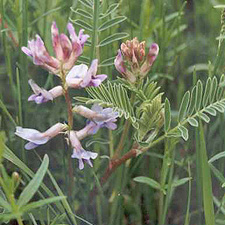
In May her plantings of extant plants included:
Northern Bush Honeysuckle,
Goldenseal,
Large Flowered Trillium,
Nodding Wild Onion,
Northern Bedstraw,
Purple Trillium
Prairie Rose,
Red Baneberry,
Shrubby St. Johnswort,
Snow Trillium,
Spiderwort
Sissileleaf Bellwort (Wild Oats).
Early Plantings not present today:
Eloise also brought into the Garden a number of new species, many are no longer extant. Many of these were native to Minnesota and a few were not. Here is a listing of those plants introduced to the Garden for the first time this spring - 1910 is the first year the following list of plants occur in her log.
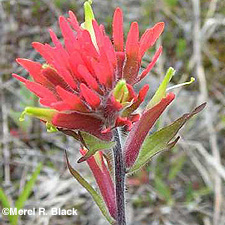
Native:
- Bearberry (Kinnikinnick); (M.C.), (Arctostaphylos uva-ursi); Kelsey's Nursery, North Carolina. [Photo]
- Brittle (Fragile) Bladder Fern, (Cystopteris fragilis); from Excelsior Springs, MO. Extant.
- Common Goldstar (Yellow star grass); (M.C.), (Hypoxis hirsuta); Cokato, MN.
- Golden Saxifrage, (Chrysosplenium L.); Osceola, WI.
- Groundplum Milkvetch (Ground Plum); (M.C.), (Astragalus caryocarpus - now Astragalus crassicarpus var. crassicarpus); Minnehaha (Minneapolis). [Photo]
- Lance-leaf Tickseed, (Coreopsis lanceolata); Jewell's Nursery, Lake City, MN and Gillett's Nursery, Mass.
- Larkspur (Prairie) Violet (Viola pedatifida); from Minnehaha (Minneapolis). Extant.
- Lesser Rattlesnake Plantain, (M.C.), (Epipactis repens - now Goodyera repens); Kelsey's Nursery, North Carolina.
- Pasque Flowers (Cutleaf Anemone); (M.C.), (Anemone patens ssp. multifida); Minnehaha (Minneapolis).
- Scarlet Indian Paintbrush, (M.C.), (Castilleja coccinea); Fort Snelling and Mahtomedi, MN. [Photo]
- Silverberry (Elaeagnus argentea - now Elaeagnus commutata); Jewell's Nursery, Lake City, MN.
- Tobacco Root (Tap-rooted Valerian or Edible Valerian); (M.C.), (Valeriana edulis); Fort Snelling (Minneapolis).
- Widow's Frill (Starry Campion); (M.C.), (Silene stellata); Kelsey's Nursery, North Carolina [Photo above]. Extant.
- Yellow Water Buttercup; (Ranunculus flabellaris); Mahtomedi, MN.
- Yellow Indian Paintbrush (Downy Painted Cup); (Castilleja sessiliflora); Fort Snelling. (Note: Eloise does not give a botanical name, but this species is the only Yellow Paintbrush native to MN and in the area of her collection so we presume it is this species.)
Non-Native:
- Fire Pink, (M.C.), (Silene virginica); Kelsey's Nursery, North Carolina.
- Pipevine (Dutchman's Pipe), (M.C.), (Aristolochia macrophylla); Jewell's Nursery, Lake City, MN (Note - present in Minnesota, but introduced).
- Southern Arrowwood, (M.C.), (Viburnum pubescens - now Viburnum dentatum var. dentatum); from Osceola, WI. Extant.
- Sweet Birch, (Betula lenta); Kelsey's Nursery, North Carolina.
- Virginia Bunchflower, (Melanthium virginicum now - Veratrum virginicum); Kelsey's Nursery, North Carolina .[Photo]
- Withe-rod, (M.C.), (Viburnum cassinoides - now Viburnum nudum var. cassinoides); Jewell's Nursery, Lake City, MN.
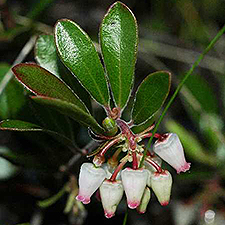
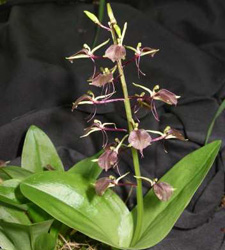
Two newspaper articles were published about the Garden in the spring. There is no by-line and the text may have been written mostly by Eloise herself. In the April 3 article where she is said to be "practically the mother of the garden," it is mentioned that only the Pasque Flower is in bloom. It had been recently planted by Eloise. A long list of plants is covered, discussing the natives vs those introduced.(2)
A May 22 article sets out the lay of the land, why the garden was established, difficulties in finding certain plants - all written similarly to other early articles Eloise wrote about the early garden.(3)
Eloise kept notes of the arrival of various birds, noting the arrival on May 8th of the Peabody Birds (An older term for a White Throated Sparrow). On May 28th she noted the Large Twayblade (Liparis lilifolia) [Photo] was in bloom. This was here first sighting of this plant thus it was indigenous. Twenty five years later Martha Crone would report replanting this species. On the same date Eloise noted that she “stroked the back of a baby crow that sat motionless on a low bough in the swamp.”
Despite the mid-April cold snap, the spring weather was actually quite warm with average temperatures well above average from mid-March to the end of April, with the pattern repeating in June.
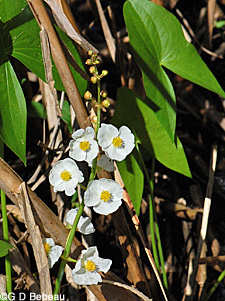
Summer began very hot and dry. Eloise noted less water in the swamp than ever before. There had been little spring precipitation and there were only two rainfalls in May and June that exceeded a quarter inch of rain.
Her planting work continued all summer. Plants arrived from Malden, Mass - these would have been shipped by her sister Cora Pease - and from New Hampshire. In addition, Eloise combed the local sources such as Fort Snelling; Clinton Ave. and 27th St.; Savage, MN; Cambridge, MN; Glenwood Springs; Breezy Point, Minnetonka; and Minnehaha Park.
Here is a list of plants introduced into the Garden during the summer months for which 1910 is the first year they occur in her log:
Native to Minnesota:
- Allegheny Monkey Flower (Square Stemmed Monkey Flower), (M. C.), (Mimulus ringens); Savage, MN.
- Beck's Water Marigold, (Bidens beckii); Brownie's Pond, Minneapolis.
- Broadleaf Arrowhead (Duck Potato), (Sagittaria variabilis - now - Sagittaria latifolia); Brownie's Pond, Minneapolis. [Photo]
- Carolina Larkspur, (Delphinium penardii -now - Delphinium carolinianum ssp. virescens); Brownie's Pond, Minneapolis. [Photo]
- Curly-cup Gumweed, (M. C.), (Grindelia squarrosa); Glenwood Park (Minneapolis).
- Marsh Hedge Nettles, (Stachys palustris), Zumbra Heights, MN.
- Single Delight (One-flowered Pyrola), (M. C.), (Moneses uniflora); New Hampshire - not specified but probably William's Nursery in Exeter which is a source she used.

Non-Native:
Water Pepper (Marshpepper knotweed), (M. C.),(Polygonum hydropiper); from the Peninsula.
A few of the more unusual plants (that had also been planted in previous years) were Moccasin Flower (Cypripedium acaule);
Smooth Forked Nailwort, (Anychia dichotoma) and
Tall Wormwood (Artemisia caudata - now named Artemisia campestris subsp. caudata). Only the Tall Wormwood would still exist in 1951 when Martha Crone took a complete plant inventory and it is no longer extant.
There was also a planting of species that still exist in the Garden today, including:
Cup Plant,
Flowering Spurge,
Gray-headed Coneflower,
Great Blue Lobelia,
Heartleaf 4-O'clock,
Hedge Bindweed,
Purple Prairie Clover,
Stiff Coreopsis,
Stiff Goldenrod,
Veiny Pea,
White Prairie Clover,
Whorled Milkweed.
Eloise also noted for the first time the presence in the Garden of these three native plants:
- Large-leaf Avens (Big-leaved Avens), (Geum macrophyllum). Not extant.
- Norwegian cinquefoil (Rough Cinquefoil), (M. C.), (Potentilla norvegica). Not extant.
- Poke Milkweed, (Asclepias phytolaccoides - now classified as Asclepias exaltata), extant.
The Showy Lady‘s-slipper (Cypripedium reginae) bloomed on June 23 which was quite late in the range of dates for that plant to bloom.
The more unusual things that Eloise would report in her Garden Log included the Goldenrod being already in bloom on July 19th and of seeing a snake swallowing a frog.
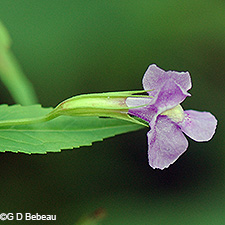
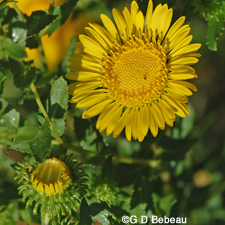
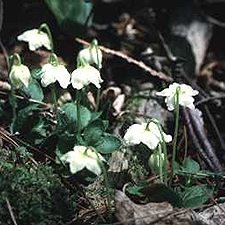
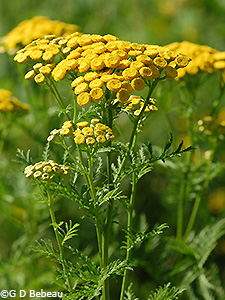
Eloise noted the return of Cedar waxwings on September 8th, which would be an early date for their migration. September 10th she found two large puffballs in Puffball Flats.
A few more plantings occurred in the autumn, including additional quantities of these plants, which still exist in the Garden today:
Bottle Gentian,
Flowering spurge,
Gray-headed Coneflower,
Leadplant,
Purple Prairie Clover,
White Prairie Clover.
Eloise also planted more Wild Yam (Dioscorea villosa); [still extant] -which she had previously planted in 1907 and 1909, and Tansy (Tanacetum vulgare). The latter is not native but introduced to North America and is in fact considered today a noxious weed in many states and removal is recommended - but it is pretty. She noted planting it next to the Creeping Charlie (Glechoma hederacea) - another invasive, in order to help contain it as she explains in this article.
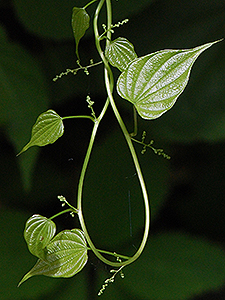
On October 22nd a dozen bulbs of Canada Lily (Lilium canadense) and a dozen bulbs of Turk’s cap Lily (Lilium superbum) all from Northrup King, were planted. That was her last recorded planting of the season. No new species were introduced in the Autumn.
Her last Garden log entry was on November 12th when she sited a pair of Bohemian waxwings.
In the fall she delivered a paper at the meeting of the Minnesota Academy of Science and also had an exhibit about the Garden at the Minnesota State Fair. A photo of it appeared in Minneapolis Tribune (PDF Copy). We believe 1910 is the first year because she wrote in the 1911 Annual Report of the Board of Park Commissioners that “A second exhibit of the Garden was made at the State Fair.”

It was a large exhibit consisting of 54 species of trees, 84 shrubs and 400 herbs. Over 100 photographs taken by Mary Meeker, many colored by hand, were on display including several large photos of Garden scenes. The exhibit of correctly named wild flowers won the first premium. The photos then went to the public library for display. (4)
The fall weather continued warmer than average in most of October with very little rain and only about four inches of snow before New Years. This was very different from the prior year when there was ample moisture that left a good snow pack coming into 1910. But once the snows stopped in February, 1910 had turned very dry. As of 2021, the year 1910 was still the driest in modern history with only 11.54 inches of precipitation. March was the warmest March in all history.
The 1910-1911 school year was now in session and this would be the last year of teaching for Eloise as she would retire in the spring of 1911.
Photo top of page: Dutchman’s Breeches (Dicentra cucullaria) in the Woodland Garden in early May. Photo ©G D Bebeau
Printable PDF file of this page.
NOTES:
(1) "Wild Flower Garden City Park's Feature" Minneapolis Tribune March 26, 1911. (PDF copy)
(2) "Beautiful Flower Beds All Ready to Blossom," Minneapolis Tribune, April 3, 1910. (PDF copy)
(3) "Glenwood Garden Spot Real Mirror of Nature," Minneapolis Tribune, May 22, 1910. ((PDF copy))
(4) Article in Minneapolis Tribune, September 9, 1910 and Twenty-ninth Annual Report of the Board of Park Commissioners.
Links to related pages:
- Abbreviated Life of Eloise Butler
- Martha Crone - 2nd Garden Curator
- Ken Avery - 3rd Curator and Gardener
- Cary George - 4th Gardener
- Our Native Plant Reserve - Short document on the origins of the Garden.
- Eloise Butler's writings, a selection of essays written by Eloise Butler on the early Garden years.
- Geography of the Garden- an illustrated tour
References:
Garden Log - Native Plant Reserve, Glenwood Park, Minneapolis, MN by Eloise Butler.
Martha Crone's Garden Log and her 1951 Census of plants in the Garden.
Various papers and correspondence of Eloise Butler in the collection of the Minnesota Historical Society.
Historical Climatology of Minneapolis-St. Paul Area by Charles Fisk.